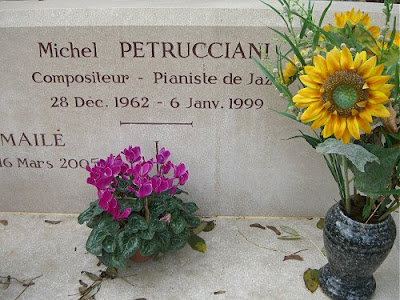What is it about this Fifth Simfony?

No, that headline is not another of my typos. In October last year I asked What is it about Fifth Symphonies? But Lou Harrison actually wrote a Fifth Simfony, and it is on the CD of his music for percussion ensemble titled Labrynth seen in my montage above. In a very informative sleeve note Art Lange describes how:
In this music, Harrison didn't merely adapt his influences into a pastiche of Asian pratctices and early music philosophies. He constructed his own methodology supported by ideas and theories gleaned from his studies and tempered through his own organizational prowess.Lou Harrison's unique approach extended beyond the musical into the linguistic. His Fifth Simfony (1939) and Labrynth No. 3 (1941) were just the starting points; he went on to compose La Koro Sutro* (1972) which sets an Esperanto text for 100 voice choir with American Gamelan, harp and organ. Lou Harrison is one of a number of creative artists who have explored alternative linguistic forms. In recent months Thomas Merton's macaronic journal My Argument with the Gestapo and Paul Griffiths' Let Me Tell You, which uses the Oulipo tradition of constrained writing, have also featured here.
I know the readership of An Overgrown Path is very broad. That is both a reward and a responsibility. For some readers Lou Harrison, with his connections to John Cage, Harry Partsch and Henry Cowell will be unexplored, if not unwelcoming territory. To these readers I recommend Labrynth. As Art Lange says in his excellent notes:
In his life, Harrison is an unabashed sensualist (for proof, read his poetry), and translated to music this is reflected in his overriding passion for melody. "Melody is the grace of music/and the beauty of its work," he once wrote in one isolated couplet.I paid just £5.37, including postage, for Labrynth from amazon.co.uk. This is a CD that rewards exploration. The sound captured in the Slee Concert Hall, University at Buffalo, New York by Swiss tonmeister Peter Pfister is truly demonstration quality. Harrison's music is performed with great flair and commitment by the Maelstrom Percussion Ensemble conducted by Jan Williams. The CD is on the Swiss Hat Hut label, which is doing really wonderful things for contemporary music and jazz. A Cageian random selection of any of the Hat Hut titles is guaranteed to challenge, educate and inspire. There are not too many record labels you can say that about today.

* La Koro Sutro is an Esperanto setting of the sacred Mahāyāna Buddhist Heart Sutra, a choice of subject that reflects Lou Harrison deep commitment to the Buddhist faith and to Eastern cultures. I make no apologies for linking this footnote to Tibetan Uprising Day on 10 March 2009, which commemorates the fiftieth anniversary of the illegal occupation of Tibet by the Chinese. Tibetan Uprising Day does not only commemorate the human genocide (a term used by the Internal Commission of Jurists) of an estimated 86,000 Tibetans in the uprising itself and more than a million in the following years. It also draws attention to the continuing cultural genocide which the Chinese government is using to destroy the centuries old culture and society of Tibet; a culture which offers real alternatives to the failing economic and social structures of the major powers. As Pico Iyer explains, the Tibetans believe that:
'Modernity has to do with a set of values rather than with a set of goods, that it is the result of a cast of mind, even more than a way of life.'Yet, 50 years after the Chinese invasion and twenty years after its leader became a Nobel Laureate, the Tibetan Government in Exile remains unrecognised by any other state. While the Dalai Lama and every other Tibetan exile has to travel on a yellow refugee ID card in place of a passport, the world powers send their fawning politicians, performers, journalists and businessmen to practise 'cultural diplomacy' at the Beijing Olympics and other Chinese propoganda events. These 'opinion formers' rush to condemn the Soviet Gulags, but ignore the fact that million of Tibetans have died at the hands of the Chinese in Amdo province in eastern Tibet and elsewhere. I am sure that Lou Harrison, whatever his current reincarnation, will understand why I will be playing his mighty La Koro Sutro very loudly today.

Other composers influenced by Buddhism include John Cage, Jonathan Harvey, Philip Glass and Edmund Rubbra. Lou Harrison's interest in the East also meant he was a great advocate of the Gamelan. So was Colin McPhee.
Lou Harrison and Free Tibet mandalas are (c) On An Overgrown Path 2009. Middle image is a Wheel of Time Mandala (Kalachakra Mandala). Any copyrighted material on these pages is included as "fair use", for the purpose of study, review or critical analysis only, and will be removed at the request of copyright owner(s). Report broken links, missing images and errors to - overgrownpath at hotmail dot co dot uk








Comments
http://www.timesonline.co.uk/tol/news/world/asia/article5870898.ece
Thomas Merton was one of the first Western visitors to travel to Dharamsala to see Tibet in exile and meet with the Dalai Lama. Thomas Merton spent some days in Dharamsala in 1968, a few weeks before he died in Bangkok -
http://www.overgrownpath.com/2008/12/sweet-irrational-worship.html
Paul Griffiths based The General, his 're-envisaging' of Beethoven's Egmont, on another terrible twentieth-century genocide, Rwanda -
http://www.overgrownpath.com/2009/02/re-envisaging-beethoven.html
The population of Llasa is now 200,000, an increase of tenfold since 1950. The area of the city has increased by twenty times, and high-rise buildings are being encouraged close to sacred shrines